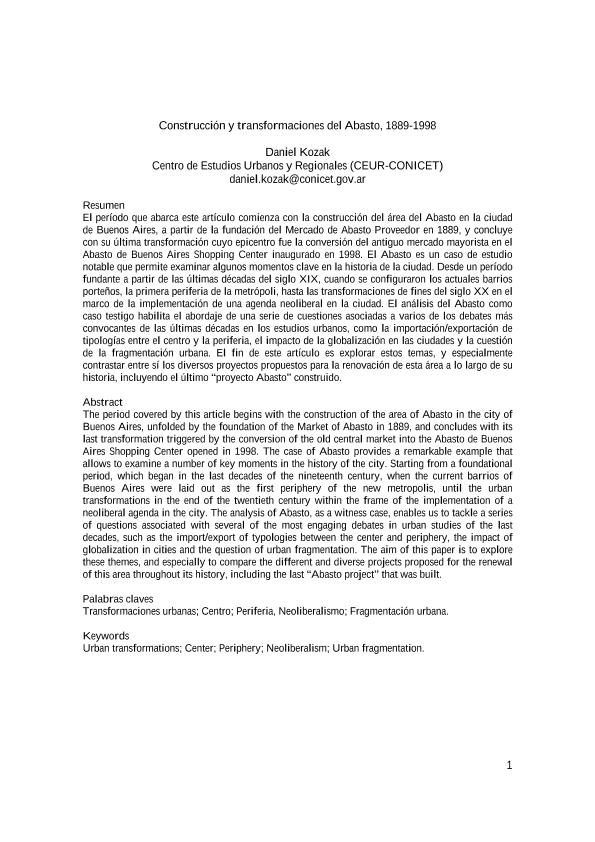Artículo
El período que abarca este artículo comienza con la construcción del área del Abasto en la ciudad de Buenos Aires, a partir de la fundación del Mercado de Abasto Proveedor en 1889, y concluye con su última transformación cuyo epicentro fue la conversión del antiguo mercado mayorista en el Abasto de Buenos Aires Shopping Center inaugurado en 1998. El Abasto es un caso de estudio notable que permite examinar algunos momentos clave en la historia de la ciudad. Desde un período fundante a partir de las últimas décadas del siglo XIX, cuando se configuraron los actuales barrios porteños, la primera periferia de la metrópoli, hasta las transformaciones de fines del siglo XX en el marco de la implementación de una agenda neoliberal en la ciudad. El análisis del Abasto como caso testigo habilita el abordaje de una serie de cuestiones asociadas a varios de los debates más convocantes de las últimas décadas en los estudios urbanos, como la importación/exportación de tipologías entre el centro y la periferia, el impacto de la globalización en las ciudades y la cuestión de la fragmentación urbana. El fin de este artículo es explorar estos temas, y especialmente contrastar entre sí los diversos proyectos propuestos para la renovación de esta área a lo largo de su historia, incluyendo el último "proyecto Abasto" construido. The period covered by this article begins with the construction of the area of Abasto in the city of Buenos Aires, unfolded by the foundation of the Market of Abasto in 1889, and concludes with its last transformation triggered by the conversion of the old central market into the Abasto de Buenos Aires Shopping Center opened in 1998. The case of Abasto provides a remarkable example that allows to examine a number of key moments in the history of the city. Starting from a foundational period, which began in the last decades of the nineteenth century, when the current barrios of Buenos Aires were laid out as the first periphery of the new metropolis, until the urban transformations in the end of the twentieth century within the frame of the implementation of a neoliberal agenda in the city. The analysis of Abasto, as a witness case, enables us to tackle a series of questions associated with several of the most engaging debates in urban studies of the last decades, such as the import/export of typologies between the center and periphery, the impact of globalization in cities and the question of urban fragmentation. The aim of this paper is to explore these themes, and especially to compare the different and diverse projects proposed for the renewal of this area throughout its history, including the last "Abasto project" that was built.
Construcción y transformaciones del Abasto, 1889-1998
Título:
Construction and transformations of Abasto, 1889-1998
Fecha de publicación:
12/2011
Editorial:
Universidad de Buenos Aires. Facultad de Arquitectura, Diseño y Urbanismo
Revista:
Anales del Instituto de Arte Americano e Investigaciones Estéticas
ISSN:
1853-5518
Idioma:
Español
Tipo de recurso:
Artículo publicado
Clasificación temática:
Resumen
Palabras clave:
Transformaciones Urbanas
,
Grandes Proyectos Urbanos
,
Fragmentacion
,
Abasto
Archivos asociados
Licencia
Identificadores
Colecciones
Articulos(CEUR)
Articulos de CENTRO DE ESTUDIOS URBANOS Y REGIONALES
Articulos de CENTRO DE ESTUDIOS URBANOS Y REGIONALES
Citación
Kozak, Daniel Matias; Construcción y transformaciones del Abasto, 1889-1998; Universidad de Buenos Aires. Facultad de Arquitectura, Diseño y Urbanismo; Anales del Instituto de Arte Americano e Investigaciones Estéticas; 41; 2; 12-2011; 213-230
Compartir




